| In the first draft of this paper
several months ago, the title was "Is There a Problem." The events
of the last month have answered that question with a resounding
YES. We now are experiencing a taste of what the future holds. The
problems have been building for quite some time and Katrina has
triggered the first in a series of crises. Nevertheless, there
still are many people in this county who think the natural gas
(NG) and oil problems are only temporary. They argue that high
prices will trigger demand reductions and technological
innovations that will bring prices back down to “normal” levels
within a few years. However, the optimistic analyses I have seen
typically exclude or ignore key considerations. When you consider
all of the relevant supply-side and demand-side factors, it is not
possible to conclude that these problems are temporary.
The latest Energy Outlook published by the US DOE predicts that
oil and gas consumption will increase steadily until at least
2025. This forecast assumes that US producers and foreign
suppliers will provide a steadily increasing flow of oil and gas.
The data on the following pages shows that it is extremely
doubtful that they can or would do so. We are far more likely to
see flat or declining supply. If demand keeps growing and we do
not come up with alternative energy sources, we will see shortages
and turmoil that exceeds Katrina’s aftermath.
The US economy and infrastructure is built on cheap energy and
is highly dependent on a continued, reliable supply of inexpensive
energy. However, that era is rapidly disappearing and we must
adapt to significantly higher energy prices. The following
assessment should help those who still are in denial finally
acknowledge that we have a problem and accept the fact that we
must change our behavior. We need to focus on creating a
sustainable energy future. Doing so will require massive changes
in infrastructure and lifestyle. There is no quick fix available.
Further delaying action will only make the transition more
expensive and painful.
Situation Summary
We have begun a forced transition from a period of adequate
energy supply and low prices to an era of persistent shortages.
The basic reason is that growing demand for both natural gas and
oil is colliding with shrinking supplies. Domestic production of
both of these resources peaked back in the 1970s and growing
demand has been satisfied by a steady increase in imports. This
trend cannot be maintained indefinitely. Contrary to many
forecasts, consumption of oil and gas will shrink in coming years
due to supply and economic constraints. The most optimistic
outlook is that we will see a slow reduction stretched out over
decades. However, we also could see a rapid decline over a short
period of time – the “falling off a cliff” scenario.
Most demand for both resources is highly inflexible and we are
producing them at essentially 100% of effective capacity. There is
no margin in the system and as we are seeing now, small shortfalls
lead to price spikes and economic disruption. Technological
innovations will help mitigate future shortages, but those
improvements will only postpone the problems temporarily. Since it
will take decades to ramp up production of alternate energy
sources and dramatically reduce consumption, it will be virtually
impossible to avoid periodic severe problems.
My forecast is that the transition will be characterized by a
series of “boom / bust” cycles. Periods of tight supply will lead
to shortages and high prices which trigger economic downturns.
Lower demand during the downturns will lead to periods of adequate
supplies and (relatively) low prices. The timing and magnitude of
these fluctuations will depend on factors that are beyond our
control or ability to predict – i.e., weather, the strength of the
US and world economy, political turmoil, the success of efficiency
improvement and alternate fuels programs, the success of NG
exploration efforts, and the rate of growth of liquefied natural
gas (LNG) imports. Given the current supply situation, political
climate, and decision maker behavior patterns, there is little
doubt that the US will experience several periods of severe
economic and social disruption before the country adapts to a
world of expensive energy.
On the NG side, we should see the first significant shortages
when the period of exceptionally mild weather that began in early
2003 ends – the hot weather of this summer may signal the end of
this period. North American NG production has been declining for
the last few years in spite of a massive increase in drilling.
Hence, periods of “adequate supply” should become increasingly
shorter over the next few decades unless we experience a major
protracted economic downturn. Aggressive action to locate new
sources, improve energy efficiency and produce alternate fuel
supplies could stretch out the “adequate supply” periods and the
transition period. However, at some point in the relatively near
future we will enter a period of permanent NG shortages.
Our NG problems are dominated by North American supply and
demand issues, but oil markets are affected by events throughout
the world. Predictions of when the peak in worldwide oil
production will occur vary, but many (if not most) analysts
predict that the peak will occur within the next decade. While
supply will begin declining shortly, oil demand is poised to grow
tremendously, largely due to rapid economic growth in China,
India, and other developing countries. Liquid fuels are essential
for transportation and many other uses and there are no suitable
near-term substitutes for oil in most of these applications. Given
the worldwide lack of surplus production capacity, we are certain
to experience periodic crises triggered by political turmoil,
weather or geological catastrophes, or simply suppliers’ inability
to increase production during periods of high demand. During these
periods prices could spike to levels well above previous highs
(around $110/bbl in 2004$).
Oil shortages and the resulting price spikes also will lead to
intense political conflicts. The developed world will fight for
the energy needed to maintain current lifestyles while the
developing world will fight for the energy needed to grow their
economies and improve their lifestyles. When shortages appear, the
level of frustration and desperation can escalate rapidly. If the
situation becomes intolerable, violent confrontations and possibly
military action become increasingly likely.
Natural Gas Situation
Economic Considerations
Natural gas production capacity in the US exceeded demand by a
comfortable margin from the early 1980’s until around 2000 when
rising demand ran into shrinking production as shown in Figure 1.
Figure 2 shows that prices stayed relatively low prior to 2000,
but they have been extremely volatile and trending upward since
then (Note: Fig. 2 shows national average prices; spot market
prices have been significantly higher in recent years). Basic
economics tells us that when demand exceeds supply, prices will
rise until sufficient demand is destroyed or new supplies are
available to bring the market back into equilibrium. If the high
prices do not destroy enough demand to bring the market into
balance, supply interruptions occur and/or the government will
step in to allocate supply.
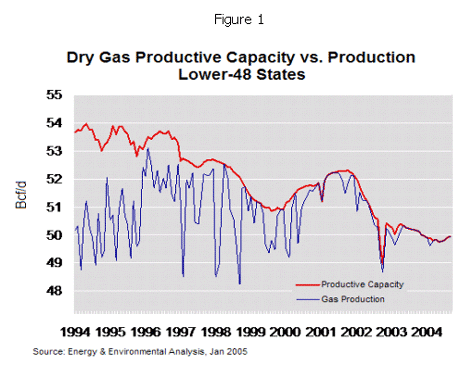
Recent experience has clearly demonstrated that the price
elasticity of remaining natural gas demand (a large share of
industrial demand already is gone) is very low, which means that
large price increases are needed to significantly reduce demand.
When demand equals or exceeds supply, a small demand or supply
change can dramatically affect price (one analyst estimated that a
2.5% reduction in NG demand during the last spike would have
reduced prices by around 25%). Consumption trends clearly indicate
that the major NG and oil prices increases of the last few years
have not been large enough to generate a significant demand
reduction. This reinforces the conclusion that prices will need to
rise far higher to reduce demand if significant supply shortages
occur.
High prices in the last few years have led to a major increase
in drilling which has generated some new supplies. However, the
production industry’s efforts to halt the decline in total
production that started in 2002 have been unsuccessful. Even
higher prices should stimulate additional drilling, but several
factors constrain the industry’s ability to increase production.
These factors include drilling capacity limits (virtually all
available drilling are in use already), the downward trend in NG
volume per well, a shortage of attractive exploration targets
(which largely is due to federal and state restrictions on
exploration), and industry risk-aversion born from extreme
financial turmoil in the 1980s and 1990s.
An added problem is that extreme price volatility will continue
to have a negative impact on efficiency improvement & substitution
activities. Energy is a relatively small portion of their total
costs for most users and decision makers are reluctant to invest
limited resources in energy systems. This is particularly true
when they do not have reliable price projections. Consequently
investment will be limited until decision makers are confident
that 1) the “low” prices during the down cycles still will be high
enough to justify the investment, 2) the risk of not acting is
significantly higher than the risk of acting, or 3) government
action creates floor prices (e.g., an energy tax that creates a
floor for market prices).

Supply Considerations
The NG industry is struggling to maintain output at current
levels, but analysis of recent trends and available data indicates
that they are not likely to succeed.
- Production from conventional onshore wells peaked in the
1970s and has been steadily declining since. (Figures 3, 4 and
5).
- Increased production from offshore and non-traditional
sources (e.g., coal bed methane, deep water drilling) and
increased imports have offset the decline in conventional
onshore production.
- Total production peaked in 2002 and then declined 2-4% in
2003 plus 1-4% in 2004 (estimates vary).
- The annual depletion rate for proven reserves rose from
around 16% in 1990 to 25% in 2000 and it appears to be steadily
rising (Figure 6). At a 25% rate, around 5.5 – 6 trillion cubic
feet (TCF) of new supply must be acquired each year to keep
total supply flat.
- The Energy Information Administration (EIA) reports that
proven reserves of dry natural gas increased by 3.3% in 2001,
1.9% in 2002, and 1.1% in 2003. Note that the rate of growth
decreased steadily in spite of a major increase in drilling
since early 2002. (Note: the depletion rates equals the
percentage of proven reserves inventory on January 1 that is
produced during that year). The EIA numbers indicate that the
amount of gas found in 2003 equaled production + 1.1%.)
- Estimates for 2004 are not yet available, but given the
large number of oil reserve volume restatements by major oil
companies in 2004, it would not be surprising if NG reserve
estimates also are adjusted downward.
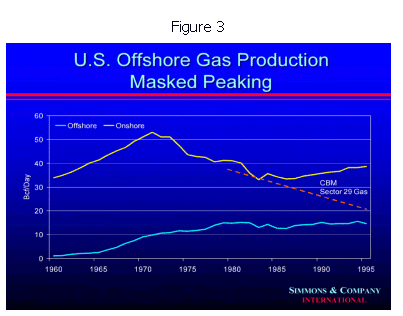



- Exploration is prohibited in some promising areas due to
environmental concerns. Given the current political climate, it
is doubtful that these areas will be opened before we experience
a major supply/price crisis. In any event, if large quantities
of gas are found in these areas, delivering this NG to the
market will be inhibited by infrastructure constraints for
several years.
- The main closed areas are in the Rocky Mountains and off
the Pacific coast, Atlantic coast, and Florida Gulf coast.
- The Rocky Mountain region contains the bulk of restricted
resources, but most of that NG is contained in tight sands and
coal beds. Developing these fields will involve drilling a large
number of small-volume wells which also requires large expansion
of the collection pipeline network.
- New transmission lines would be needed to move large
volumes of offshore gas. Transportation lines leading from the
Rocky Mountain to the rest of the country also need to be
expanded.
- Field processing equipment must be provided for all new
sources.
- Imports from Canada rose from around 1 TCF in the late 1980s
to 4 TCF (17-18% of consumption) in 2001 and have stayed near
that level since then.
- The Canadian reserves situation is similar to the US
situation and it is doubtful that exports to the US could expand
significantly.
- The Canadian government instituted NG production
restrictions in 2004 to ensure that sufficient gas is available
to extract heavy oil from their tar sand reserves, which further
inhibits their export potential.
- LNG is supposed to become a major new source, but it is
doubtful that capacity can be expanded fast enough to match
EIA’s projections.
- Annual LNG imports increased from around 0.2 TCF in 2002 to
approximately 0.5 TCF in 2003 and 0.6 – 0.7 TCF (3% of total US
consumption) in 2004. (Figure 7)
- More than 20 new import terminals have been proposed for
the US, but all analysts agree that many/most will not be built
due to local resistance and financial challenges.
- EIA projects that imported LNG will account for around 2.5
TCF in 2010 and 6.4 TCF in 2025 (Figures 8 & 9). It is unlikely
that these levels can be achieved due to infrastructure
constraints (primarily liquefaction facilities and tankers) and
the fact that we will face intense competition for available
supplies from other countries.

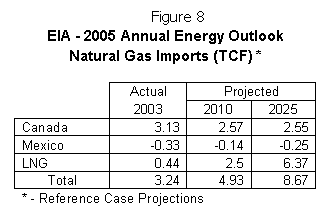

Demand Considerations
The DOE Energy Information Administration forecasts that US
consumption of natural gas will be 31 – 35 TCF in 2025, an
increase of 35 – 50% from current levels (Figure 9, 10 & 11).
However, these projections do not seem reasonable given challenges
of increasing supply which are noted above.


One projection we can safely make is that demand will fluctuate
depending on several key factors:
- The dominant factors affecting demand are weather and the
strength of the economy.
- Exceptionally mild summer and winter weather since early
2003 (the last cold winter) through the spring of 2005 was a key
factor in avoiding supply shortages and corresponding price
spikes. Increased consumption due to a hot summer was a major
contributor to the price increases in the month prior to
Katrina.
- Economic weakness in the early part of the decade helped
keep demand low.
- The main secondary factors affecting demand are fuel
switching (to oil or electricity) and efficiency improvements.
- Switching to oil has been limited by technical capability
and the fact that oil currently is more expensive than gas.
- Switching to electricity or significantly improving
efficiency frequently requires equipment changes that are
expensive and time consuming.
- Traditionally, large price-sensitive industrial loads (e.g.,
ammonia) shut down or switch to alternate fuels when NG prices
rise. Much of this load already has shut down due to high prices
in recent years, which reduces our ability to quickly reduce
demand during future price spikes.
- One leading energy industry analyst estimates that in early
2005, about 1 TCF of additional demand (or 4-5% of current
consumption) could be eliminated by another $2 or $4/MMBtu price
increase. However, most load beyond that is highly inelastic.
- NG generally is a small share of the total operating cost
of the industrial users who have not curtailed use already.
These customers’ demand will depend largely on level of output.
- Interest in improving energy efficiency spiked after the
2000/2001 NG price increase, but most of this interest lagged
when prices dropped.
- Consumer attitudes vary over a wide range, but industry
sources indicate that the majority of decision makers have not
yet changed their design/construction practices and equipment
selection practices in response to recent energy cost increases.
- It will take decades to achieve large increases in the
efficiency of buildings and energy utilization equipment (e.g.,
HVAC, cars, process equipment) that exist today.
Oil Situation
While the natural gas evaluation focused on the domestic
situation, oil must be evaluated on a worldwide basis. The
international oil outlook is just as discouraging as the US NG
situation – production is peaking when demand is poised to rise
rapidly. The factors affecting supply and demand are similar to
those affecting US NG markets. However, there are significant
differences.
Supply Considerations
While US NG production peaked over 20 years ago, worldwide oil
production has been increasing steadily for decades as shown in
Figure 12. When production will peak is unknown, but most
forecasts indicate the peak is likely occur within the next 10 to
20 years if it hasn’t occurred already – it is not possible to
identify the peak until after it happens.
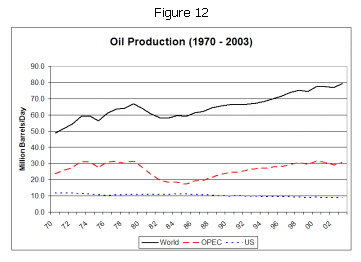
Another major concern is that the current lack of surplus
production capacity, which is illustrated in Figure 13, increases
susceptibility to disruption and price volatility.
- Most countries other than OPEC and former Soviet Union (FSU)
states are experiencing level or declining production.
- OPEC or FSU’s ability to increase production is uncertain
due to a lack of reliable reserve data and the unknown future
impact of past poor field management practices.
- Few (or no) large high-potential exploration opportunities
appear to exist in politically stable areas. There are some
significant promising opportunities in politically unstable
areas, but exploring them will be difficult and dangerous.
- In any event, the rate at which new giant oil fields are
being found has dropped to zero (Figure 14) in spite of
aggressive exploration. Only one giant field has been found
since 1995 – the Kashagan field in Kazakhstan – and there are
concerns over how much can be recovered from that field due to
serious environmental challenges. Finding an equivalent amount
of oil in small fields requires far more exploration.


Global demand was around 55 MM bbl/day in 1973, 65 in 1979,
and 70 in 1995; estimate for 2005 is around 85 MM bbl/day
Assuming 2% growth in demand and FSU and non-FSU supply flat,
projections for 2010 are:

Current OPEC call is around 30 MM bbl/day and a 50% increase
does not appear feasible under any reasonable scenario.
There is relatively high potential for supply disruption due
to widespread political problems (e.g., Iraq, Russia/Yukos, Saudi
Arabia, Nigeria, Venezuela) and terrorist action.
Another challenge we are facing is the shift in the type of
crude oil being found, which will create refining problems.
- Production of light sweet (low-sulfur) crude clearly has
peaked and is declining while production of heavy sour crude is
rising.
- A large share of worldwide refining capacity is designed for
light sweet crude. These refineries will need to add
considerable amounts of new equipment to process heavier crudes
and converting them will require major investments.
Demand Considerations
Demand by developing countries (particularly China and India)
will increase significantly as their economies are to grow
(Figures 15 & 16). Their demand growth will increase competition
for available supplies.
- Note that figures 16 & 17 presents demand in terms of
bbl/person. US consumption actually is lower than China’s
consumption when measured on a bbl/$ of GDP basis.


Other important demand-side considerations include:
- The potential for high prices and possibly shortages is
significantly higher in areas that have stringent gasoline
formulation requirements for emissions control. There are a
limited number of refineries that can produce these formulations
and disruptions in the supply of crude oil on which these
refineries are designed to operate could lead to serious
localized problems.
- The lack of good alternatives to oil for transportation,
chemical feedstock, and certain other applications ensures that
competition for available supplies will be intense, particularly
during times of high demand/supply shortage.
- A significant share of the recent US price increases is due
to the weakness of the US dollar in recent years (Figure 17).
Further declines would have a disproportionate impact on the US
and countries that have tied their currency value to the US
dollar.
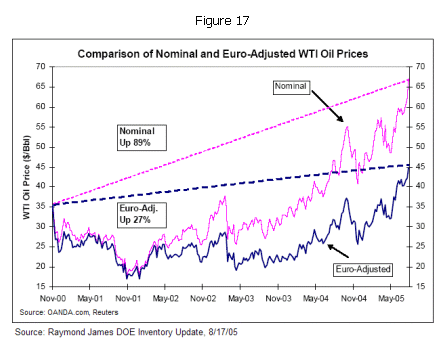
Part 2 of this assessment will address:
- What can be done to mitigate these problems
- What are the main barriers we need to overcome
- Why should you believe this assessment rather than the more
optimistic forecasts
To join in on the conversation or to subscribe or visit
this site go to: http://www.energypulse.net
Copyright 2005 CyberTech, Inc.
|

